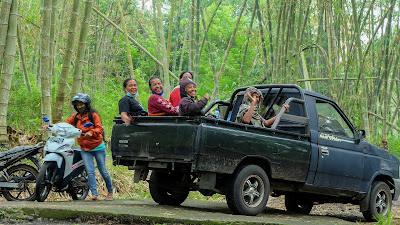...
Arief Rabik from Environmental Bamboo Foundation says, currently, the world emits up to 40 billion tons of carbon dioxide into the atmosphere every year.
Tropical rainforests are important to us as humans because it's the foundation of Earth's life support systems. "And in those life support systems you have more than half of the plants and animals on the planet, and we need to understand that without these healthy soils, without healthy water systems, without healthy air, we cannot survive," Rabik said a few days ago via a short video.
The Environmental Bamboo Foundation is not only trying to stop these forests from disappearing, but trying to restore the degraded lands that were the forests of the past.
"We want to create what we call a Restoration Economy, where people, especially rural farming communities can actively restore these degraded lands and make a very good economy for themselves, their families, and their communities."
Through the 1000 Bamboo Village program, Rabik hopes village-owned enterprises to produce value-added bamboo, at the village level by creating an integrated forest to the factory production system.
"Our 1000 Bamboo program is a holistic system where we take degraded land we introduce native species and set aside areas for food crops and cash crops within this larger agroforestry reality," he said.
One of the key benefits of their agroforestry system is that create knitted hydrology of short, medium, and deep roots to create a sponge that holds water in the soil and helps these forestry systems to thrive.
According to Rabik, the global bamboo market is currently projected to reach 93 billion US dollars by 2025.
"We aim to restore 2 million hectares of degraded land. Generate an industry revenue of 6-9 billion U.S. dollars per annum. And create more than 1 million jobs in the process."
The bamboo village program allows farmers to produce two main bamboo products. Bamboo strips and bamboo pellets. Strips are the raw material for bamboo planks. "That can supply woodworking industries of the world," he said.
Bamboo pellets are a by-product of strip production and are an excellent source of carbon neutral bioenergy, that can generate electricity and provide a safe fuel for cooking.
Globally the main bamboo markets are for the food industry, the construction industry, for the textile industry. "I am wearing a nice bamboo shirt today and most interestingly are, to take the wastes from a lot of these industries and press it into a little pellet that can become renewable energy of the future," Rabik said.
Rabik then explained, to successfully execute the 1000 bamboo village vision, they have 5 key pathways including: strengthening investment drivers for bamboo, creating the bamboo village app, sustainable bamboo certification, activating markets and the national strategies
Rabik said, "The first pathway is what we call the strengthening investment drivers for bamboo, and that means to convince farmers, and businesses, and bankers that bamboo is a very good investment."
The second pathway is to create the bamboo village app. It means they want to bring farmers and markets together on one online platform providing a gateway for all transactions. "to take place while rating the performance and quality of each of these farmer cooperative suppliers," he said.
The third pathway is to create a certification system to ensure the supply chain and value chain for bamboo are sustainable, including working with the Forestry Stewardship Council to make it happen.
"So buyers can follow the entire chain custody and know that the bamboo they buy is both sustainable and supportive of local communities."
The fourth pathway is to activate markets for bamboo and work with different international and domestic partners to make sure that all the bamboo gets bought.
"The fifth pathway is to take the first, second, third, and fourth pathway bring them together, and create a national and international strategy for the community base bamboo industry," Rabik said.
In Rabik opinion, it is to harness the resources needed to make the community-based bamboo industry a success, not only in Indonesia but worldwide.
This national strategy is supporting farmers to grow bamboo on these degraded lands, manage forestry management systems, build a village-based factory and sell pellets and strips at a fair price that allows them to understand, how much money they are making at the end of the month, and the end of the year, and in the future.
"So they can send their kids to school, as well as restore the degraded lands around them," he said.
Today, bamboo really does have something for everybody. The textile industry has a sustainable cotton alternative and the construction industry has a sustainable wood alternative.
"The energy industry has a new rapidly renewable energy source,"
With investment, in the next five years, Rabik believes, they can create 1000 bamboo villages around Indonesia that empower more than 1 million people to enter this restoration economy and restore 2 million hectares of degraded land and create this template here in Indonesia.
"So we can show it to the world," he claimed. (jacko agun)


Tidak ada komentar:
Posting Komentar